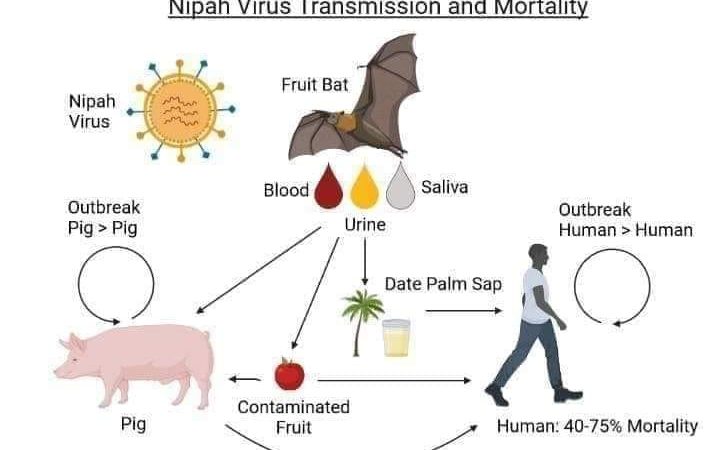Introduction
The Nipah virus is a highly lethal zoonotic pathogen that first emerged in Malaysia in 1998. Since then, it has sporadically caused outbreaks in South Asia, posing a significant public health threat. This comprehensive article delves into the history, distribution, symptoms, treatment, prevention, and recent medical advances related to the Nipah virus.
History
Emergence in Malaysia (1998)
The Nipah virus was first identified in Malaysia in 1998 during an outbreak among pig farmers and those in close contact with them. This outbreak was initially misdiagnosed as Japanese encephalitis, highlighting the virus’s ability to mimic other diseases. The virus caused severe respiratory and neurological symptoms, leading to a high mortality rate of around 40%.
Sporadic Outbreaks in South Asia
After the Malaysian outbreak, sporadic outbreaks of Nipah virus infection have occurred in Bangladesh and India. The virus primarily spreads from fruit bats to humans through the consumption of contaminated date palm sap or close contact with infected animals. Human-to-human transmission has also been documented, particularly in healthcare settings.
Distribution
Natural Reservoir
Fruit bats, particularly species from the Pteropodidae family, are the natural reservoirs of the Nipah virus. These bats do not typically display symptoms of the disease but can shed the virus in their saliva, urine, and feces, contaminating the environment and fruit that they feed on.
Geographic Distribution
Nipah virus outbreaks have been reported in several countries in South and Southeast Asia, including Malaysia, Singapore, India, and Bangladesh. These regions are particularly vulnerable due to the presence of fruit bat populations and cultural practices involving the consumption of date palm sap.
Symptoms
Incubation Period
The incubation period for Nipah virus infection is typically 4 to 14 days, although it can extend up to 45 days.
Early Symptoms
Early symptoms of Nipah virus infection include fever, headache, dizziness, and vomiting. These symptoms are nonspecific and can be mistaken for other common illnesses.
Progression to Severe Disease
As the infection progresses, individuals may develop severe respiratory distress, encephalitis (inflammation of the brain), and neurological symptoms such as seizures and altered mental status. The disease often leads to a coma within a few days, and mortality rates can exceed 70% in some outbreaks.
Treatment
Supportive Care
There is no specific antiviral treatment for Nipah virus infection. Therefore, medical management primarily involves supportive care. Patients may require mechanical ventilation, fluid management, and treatment for complications such as seizures.
Experimental Treatments
Several experimental treatments have been explored, including the use of antiviral drugs and monoclonal antibodies. These therapies have shown promise in animal studies but have not been widely tested in humans.
Prevention
Reducing Bat-Human Contact
- Avoid Handling Bats: Individuals should avoid handling bats, especially those found sick or dead.
- Protective Clothing: People working in areas with high bat populations, such as farmers, should use protective clothing like gloves and masks.
- Avoid Consumption of Raw Date Palm Sap: Efforts should be made to discourage the consumption of raw date palm sap, which can be contaminated with the virus.
Infection Control
- Isolation Precautions: Healthcare facilities should implement strict infection control measures to prevent human-to-human transmission.
- Quarantine and Contact Tracing: Identifying and isolating infected individuals and tracing their contacts is crucial to containing outbreaks.
Public Health Education
Raising awareness about Nipah virus transmission and prevention is essential, especially in high-risk areas. Public health campaigns can help educate communities on safe practices.
Recent Medical Advances
Vaccines
Research on Nipah virus vaccines has made significant progress in recent years. Several candidate vaccines are in development, with some showing promising results in animal studies. Vaccination of high-risk populations, such as healthcare workers and farmers, could be a crucial step in preventing future outbreaks.
Monoclonal Antibodies
Monoclonal antibodies, designed to target and neutralize the Nipah virus, are being explored as a potential treatment option. Early studies in animal models have demonstrated their effectiveness, sparking hope for their use in human cases.
Antiviral Drugs
Efforts to develop antiviral drugs specifically targeting Nipah virus replication are ongoing. These drugs could potentially offer a more targeted and effective treatment option compared to supportive care alone.
Conclusion
The Nipah virus remains a significant public health concern, particularly in regions where it has caused outbreaks. While there is no specific treatment for Nipah virus infection, advances in medical research offer hope for the development of vaccines, antiviral drugs, and monoclonal antibodies. Prevention efforts focus on reducing bat-human contact, implementing strict infection control measures, and raising public awareness. Continued research and international collaboration are vital in mitigating the impact of this deadly virus and preventing future outbreaks.
You May Also Like –The Miraculous Broadleaf Plantain


